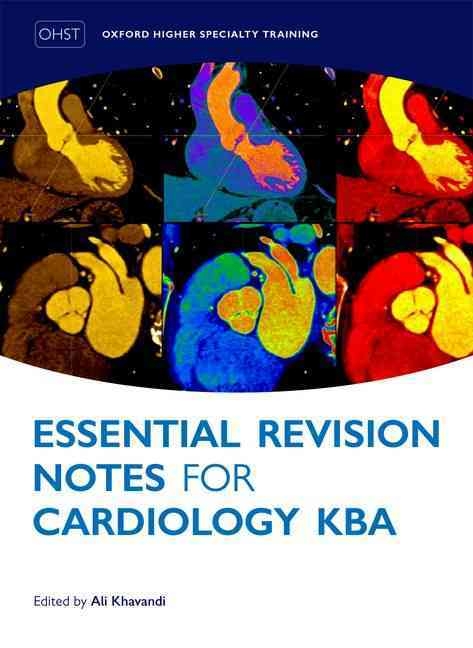Essential revision notes for cardiology KBA
 Author: Khavandi A
Author: Khavandi A
Publisher: Oxford University Press, 2014
ISBN: 978-0-19-965490-1, Price: £59.99
The authors have been very successful at publishing the first knowledge-based assessment (KBA) revision aid – a well structured book which, over 32 chapters, comprehensively provides an excellent overview of the UK national curriculum and closely follows the European curriculum, making it an ideal preparation tool for the European Exam in Cardiology. The wealth of information in each chapter makes it relevant to both those in training but also consultants who may wish to use it as a quick reference book or to help with teaching.
It has mostly been written by senior trainees and some new consultants, with input from specialists to deliver authoritative and assuring chapters, yet being sympathetic to the angle to which a trainee approaches cardiology. Chapters are bursting with diagrams, tables and electrocardiograms (ECGs), which make it light reading, and the bullet points allow concise information to be packed in, in a no-nonsense fashion. The text is easily digestible and the content up to date and accurate.
This book bridges the gap between a large, highly detailed reference book, and a small pocket guide. It is an absolute must for those in training, and anyone interested in cardiology.
Hannah ZR McConkey
Cardiology SpR
Oxford Deanery
Inherited cardiac diseases
Editors: Elliott P, Lambiase PD, Kumar D
Publisher: Oxford University Press, 2011
ISBN: 978-0-19-955968-8 Price: £39.99
From the highly popular series of Oxford Specialist Handbooks in Cardiology, the first edition on the subject of inherited cardiac disease presents a concise and comprehensive overview of the conditions and issues encountered in the clinical practice of this subspecialty. Edited by leading experts in the field, with contributions from other consultant specialists and fellows, this book was written with the trainee in mind undertaking a rotation or specialising in this area. The insightful chapters on genetic counselling and point style management plans written for commonly encountered conditions in clinical practice also make this an indispensable pocket reference for specialists, nurses and counsellors.
Arranged over 20 chapters, the first third of the book covers the fundamentals in genomics, common laboratory investigations, and pointers on genetic counselling, providing an appropriate introduction to this field of cardiovascular medicine. The following chapters on the inherited cardiac conditions each contain a wealth of information on pathophysiology, risk stratification and management, and are appropriately sub-headed to allow quick navigation and easy assimilation. The book finishes by including practical information on managing the cardiovascular manifestations of other inherited diseases, such as skeletal muscle disease, mitochondrial disease and metabolic disease, which are an important and easily neglected part of a trainee’s core knowledge.
The authors have made an effort to include important clinical guidelines from Europe and North America, and kept the information current at the time of writing. Whilst new guidance and consensus documents have since been published (e.g in hypertrophic cardiomyopathy), this book’s contents and practical guidance still remain entirely relevant. Overall, the book is a worthy addition to the Oxford Specialist Handbooks series and is highly recommended to anyone with an interest in the inherited cardiac conditions.
Kevin Leong
Cardiology Registrar
Fu Siong Ng
Clinical Lecturer in Cardiology
Imperial College London and Imperial College Healthcare NHS Trust, London
Oxford handbook of heart failure (second edition)
Authors: Gardner RS, McDonagh TA, Walker NL
Publisher: Oxford University Press, 2011
ISBN: 978-0-19-967415-2 Price: £39.99
‘Doing more with less’ is a concept few us can escape grappling with. Remarkably, this handbook delivers. Despite being 10% shorter than the previous edition of this popular title within the Oxford Specialist Handbooks in Cardiology series, it continues to offer a comprehensive yet focused manual for all clinicians looking after patients with heart failure.
The structure of the book retains the logical approach of the first edition, dealing with pathophysiology, investigation and treatment, before moving on to a series of high-yield chapters targeting specific comorbidities. The authors have struck a good balance between describing management and facilitating more in-depth understanding. Further sections on procedures and the evidence base underlying specific interventions are equally valuable whether read in their entirety or dipped into. Chapters dealing with specific therapeutic agents cater for all, blending a useful summary of landmark randomised controlled trials (RCTs) with practical dosing suggestions.
Increased coverage of mechanical circulatory support (now meriting its own chapter) is particularly welcome and offers an accessible summary of the area for those of us not regularly involved with advanced heart failure. A second new chapter provides a valuable summary of the complexities of right ventricular dysfunction with a helpful division of management strategies by pathophysiology. Style, language and formatting follow the tried and tested Oxford Specialist Handbook template, with helpful cross-references to other areas of the book and candid ‘bomb sign’ annotation of controversial topics. Where uncertainty in the evidence base exists, for example in the heart failure with preserved ejection fraction (HF-PEF) chapter, the authors have transparently reminded readers at the start of the section.
As the prevalence of heart failure increases, more of us will encounter more patients with heart failure. The national audit for heart failure shows that specialist input has been associated with dramatically improved outcomes. Future therapeutic innovations are likely to be hard-won incremental advances, making it all the more important that we offer existing evidence-based practice to all patients who might benefit. The author’s preface to this edition aspires to improve outcomes for our patients and I believe this book is a useful tool to achieve this.
It is one thing to know “what to do” but another to know “why to do it,” and it is a real achievement to discuss both usefully within 500 pages. Writing a book that is accessible to all but maintains the interest of specialists is a tall order. The authors should be congratulated on a concise, balanced and well-pitched offering.
Graham Cole
Clinical Research Fellow
Imperial College London
